
Pollinating Sausage Trees
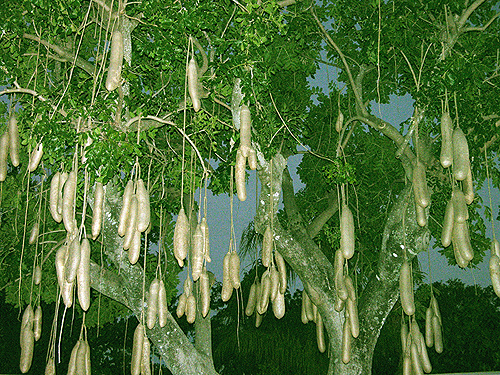
The Sausage Tree, Kigelia africana, is a fairly inconspicuous tree when grown amongst other trees, even though it can reach a height of 40 to 50 feet.
Here in South Florida, one doesn't normally realize how many Sausage Trees are planted in our area unless the distinctive sausage-type fruit is hanging on the tree. Finding a tree with fruit is uncommon because the pollinator from its native habitat, a fruit bat, does not occur in South Florida.
Sausage Trees are native to Africa, where they are found throughout the sub-Saharan region. The fruits are often quite large and can resemble two-foot long sausages. They are wood-like and not at all palatable. Some native Africans brew beer from the fermented fruit, and the fruit is also utilized to prepare concoctions that cure a multitude of ailments from snake bites to skin problems.
The flowers (which may contain up to a teaspoonful of nectar) are visited at night in their native habitat by nectar feeding bats. During this visit the bats inadvertently pollinate the flowers by brushing against the stamens (the male part of the flower that holds the pollen) and getting pollen on their head. The pollen that is on the bat's head is then brushed onto the pistil (the female portion of the flower) of the next Sausage Tree flower that is visited.
Regarding pollination, Sausage Trees are self-incompatible: pollination and fruit set will only be successful if pollen from a different Sausage Tree is carried to the pistil of another. Since there are no nectar feeding bats in South Florida, these trees are rarely seen with fruit. However, when a tree is found with fruit and they are not the progeny of hand pollination, they were probably visited by the native Red Bellied Woodpecker or the Spot Breasted Oriole. These two birds sometimes visit the Sausage Tree in the evening just as the flowers are beginning to open, apparently looking for insects that are attracted by the nectar found inside the flower. The head of the Woodpecker is the right size to pick up pollen from one flower and carry it to another, similar to the way the bats do. The Spot Breasted Oriole, which was introduced from Mexico and has naturalized in South Florida, is the same size as the Woodpecker and also causes pollination.
Successful pollination of this tropical tree can also be done by hand. Flowers can be collected from another tree on the day before they open and the pollen will be viable for several days if kept in an airtight dry container and refrigerated. The flowers open in the evening and the pistil is receptive from early evening to mid morning the next day. Early in the night (usually), the entire corolla with the stamens attached will drop off leaving only the pistil attached to the ovary. Place the pollen from the collected flower on to the open pistil. The pollen can be brushed on using a toothpick or the entire stamen from the collected flower can be used as a pollination tool. The latter seems the easiest if there is enough pollen for all the flowers to be pollinated.
It is always a good idea to pollinate the tree over several days. Sometimes the pollen doesn't take or only a small percentage of the flowers pollinated will actually set fruit. After successful pollination, the newly forming fruit can be seen after three or four days. The fruit can take about a month to reach full size and many trees have a unique shape and size of fruit. If left on the tree, the fruits will begin to drop off in 10 to 12 months. The seeds are generally viable and can sometimes germinate while still inside the fruit.
In Africa the leaves are eaten by elephants and kudu. Nyla, kudu, impala, grey duiker, and domestic stock eagerly eat the flowers. Bushpigs are known to eat the fruit.


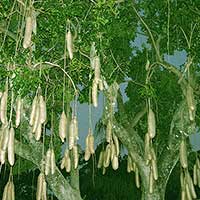
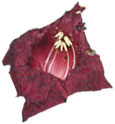

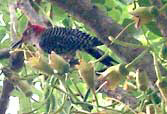
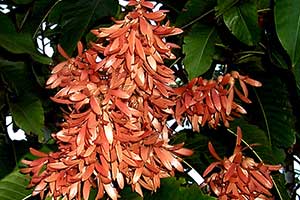 About Tropical Trees & Arboriculture
About Tropical Trees & Arboriculture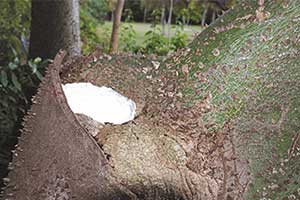 An Experiment in Arboriculture and Mosquito Control
An Experiment in Arboriculture and Mosquito Control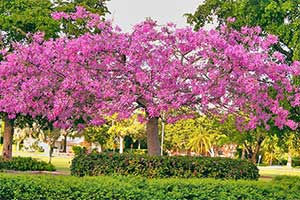 Ceiba Speciosa
Ceiba Speciosa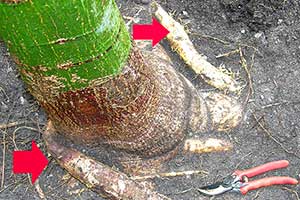 Why Trees Blow Over
Why Trees Blow Over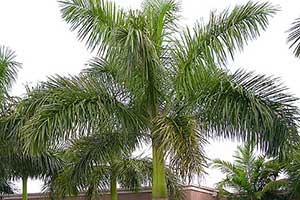 Royal Palm Bugs
Royal Palm Bugs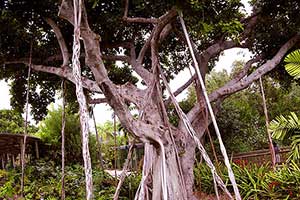 Ficus Species & Hurricane Horticulture
Ficus Species & Hurricane Horticulture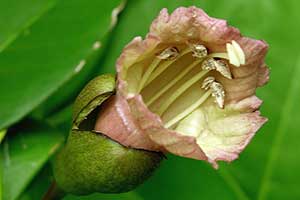 Pollination and the Natural History of the Calabash Tree
Pollination and the Natural History of the Calabash Tree Pollinating Sausage Trees
Pollinating Sausage Trees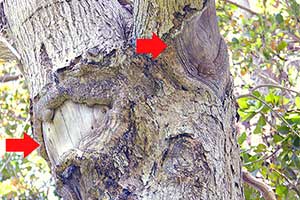 Some Observations on Relocating Tropical Trees
Some Observations on Relocating Tropical Trees